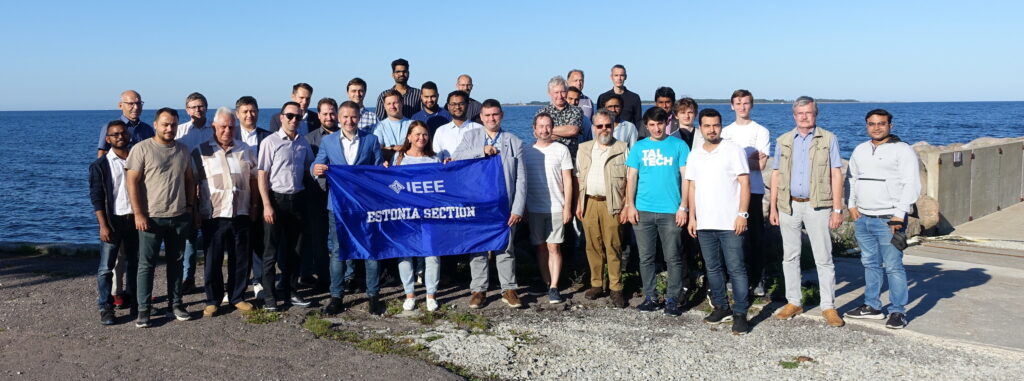Upcoming Events
News
Tarkvaraarenduse seminar
IEEE ja ESIS tarkvaraarenduse ühisseminar
21.04.2011 toimub Tallinna Tehnikaülikoolis IEEE Estonia ja Eesti Süsteemiinseneride Seltsi ühisseminar tarkvaraarenduse teemal.
Esinevad:
Jürgo Preden, “Tarkvaraarendus ja selle protsess”
Alek Kozlov, “Scrum – tänapäevane arendusmeetod”
Peale seminari jätkame teemade arutamist vabas vormis.
Toimumisaeg: 21.04.2011 17:15 – 18:30
Koht: TTÜ peamaja II korpus, ruum 309 (Automaatikainstituut)
Osalema on oodatud kõik huvilised, seminar on tasuta.
Aastakoosolek 22.12.2010
IEEE Eesti sektsiooni aastakoosolek toimub kolmapäeval, 22. detsembril 2010 kell 18.00 IT Kolledzis, Raja 4C, Tallinn ruumis 227.

Kava:
1. Urmet Jänes, Tagasivaade 2010. aastasse
2. Eiko Kängsep/Rein Sabolotny, Sektsiooni finantsaruanne
3. Kalle Tammemäe, Singapuri kõrgharidussüsteem
Õhtu jätkub vabas vormis IEEE tegevuse aruteluna kohvi ja küpsiste seltsis. Kuna samal päeval on ka TTÜ Arvutitehnika Instituudi jõulupidu, võib tekkida teatav sünergia.
Palun oma tulemisest teada anda veebiaadressil http://www.doodle.com/s2vz4uc537fpgeg7
Üritus on avatud ka mitteliikmetest huvilistele.
IEEExtreme 4.0 superedu
23. oktoobril 2010 toimunud IEEExtreme 4.0 programmeerimisvõistlus kogus rekordarvu osalejaid. Kell 0:00 UTC (3:00 Eesti ajavööndis) alanud võistluses osalesid 970 kolmeliikmelist IEEE tudengliikmetest koosnevat meeskonda. Esimesed kolm meeskonda olid pärit Valgevenest, Uus-Meremaalt ja Tartust.
Neli Tartu Ülikooli meeskonda said kõik kohad esikümnes (3., 6., 9., 10. koht). IT Kolledzi meeskond oli 180 hulgas, täpne koht on veel selgumata.
24 tundi kestva võistluse käigus tuli osalejatel kirjutada ülesannete lahenduseks 17 programmi. Uusi ülesandeid anti osalejatele varem teadmata vaheaegade järel, mistõttu pidid ka kõige kiiremad enamiku võistluse ajast ärkvel olema. Kõik ülesanded lahendasidki ainult 10 tiimi.
“Neile tudengitele, kes programmeerida oskavad ja sel aastal ei osalenud, soovitan ära proovida. Millal veel hulle tükke teha, kui mitte tudengipõlves,” ütles Ahto Truu, Tartu meeskondade kuraator.
“IT Kolledzi meeskonnale oli see elus esimene nii pikk pideva töö tegemise periood – 24 tunni jooksul majast väljas ei käidud. Võistlus algas ja lõppes meie aja järgi kell 3 öösel, nii et üht päeva nagu poleks olnudki,” kommenteeris Urmet Jänes, IT Kolledzi võistkonna kuraator.
Osalenud meeskonnad:
– võistkond SegaMegaDrive koosseisus Viktor Karabut, Aleksandr Nikiforov, Oleg Šelajev 3. koht!
– võistkond Nintendo64 koosseisus Vladislav Belous, Aleksei Lissitsin ja Konstantin Tretjakov
– võistkond LihtsaltIlusad koosseisus Mihkel Heidelberg, Margus Niitsoo, Tiina Turban
– võistkond Fyysikud koosseisus Johannes Heinsoo, Ardi Loot, Taavi Repän
– võistkond ITCollege koosseisus Indrek Ots, Urmas Sepp, Olavi Soosaar
Ametlikud tulemused: http://www.ieee.org/membership_services/membership/students/competitions/xtreme/xtreme_2010.html
Mudelipõhine tarkvaratehnika, Tallinn, 27.10.2010
Eesti Teaduste Akadeemia korraldab 27.10.2010 kell 14.00 Küberneetika Instituudis seminar-töötoa “Mudelipõhine tarkvaratehnika – tarkvara tootmise kõrgtehnoloogia.
Asukoht: TTÜ Küberneetika Instituut, auditoorium B126
Aadress: Akadeemia tee 21, Tallinn
Esinejad: Enn Tõugu, Pavel Grigorenko, Mait Harf, Andres Ojamaa, Riina Maigre
Osavõtt on tasuta.
Lisainfo (PDF)
Kaks loengut IEEE Distinguished Visitorilt
7.-8. septembril peab TTÜ arvutitehnika instituudis kaks loengut tunnustatud Duke’i ülikooli professor, IEEE fellow ja IEEE Computer Society Distinguished Visitor Krishnendu (Krish) Chakrabarty. Loengute teemadeks on uudsed, 3D integratsioonil põhinevad kiibid ning mikroelektroonikasüsteemide diagnoos. Loengute toimumist toetavad IEEE Eesti sektsioon ja IKT doktorikool.
7. september, kell 14:00, ruumis IT-209 (Raja 15)
Testing of 3D Integrated Circuits: Challenges and Emerging Solutions
8. september, kell 10:00, ruumis IT-209 (Raja 15)
Dictionary-Based Methods for Board-Level Fault Diagnosis
Loengute abstraktid ning prof. Chakrabarty biograafia on leitavad aadressil http://ati.ttu.ee/index.php?page=171&uudis=135
Lisainfo: Gert Jervan gert.jervan@pld.ttu.ee

